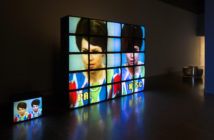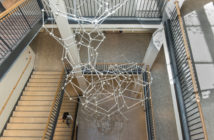It's funny how seeing art changes you and your interpretations of other work. I'm not sure I would have seen Gordon Matta-Clark's Substrait (Underground Dailies) or Rosa Barba's The Empirical Effect in the same light without having seen the other. Both owe much to Left Bank style French New Wave film; pseudo-documentary art films that express ideas or emotion through a collage of film. Both have a protagonist that is a based on nature; for Barba, the Mountain; for Matta-Clark, the tunnel. Compared to the patient sublime natural formations, the humans that surround it end up looking awkwardly young and naive. The mountain watchers practically worship it, venerating its every twitch and hiccup with a paper trail of data to observe. In the end they are trying to forecast the next event in their ancient and introverted neighbor's life. For the tunnelers, the ground's striations, the physical reality of penetrating the earth, grows into an aesthetic experience that borders on a religious tradition. Instead of observing and spreading the word of the mountain, they live with and explore the gnostic gospel of tunneling.
Though the mountain is in plain sight, still, humans need fine-tuned instruments to observe the subtle motions that the mountain makes. The tunnels are hidden from every day sight, but with just a portable flashlight, a good pair of eyes, and enough time, you can explore the caves to find a whole new experience.
Both use a reliable camera but possibly an unreliable human narrator. Did the man in Matta-Clark's film really get bit by an alligator? Did the children really get to the end of the tunnels that they said they've been to? Who knows for sure, but we do know that formally, the film is created from natural filming techniques with very little sleight of hand. These films allow the viewer to have access to a lot of information. The density of the material provides all the difficulty that these artists seek. The mountain leveled the entire town at one point, and all that we see today has grown out of that tragedy. The survivors of the last geological event (1944) are shown here, but we are not given much access to their accounts or experiences. We see them, but their stories are secondary to the mountain's. We hear more about the tunnels, but the related stories are so beyond most of our experiences that we can't confirm their reality. Besides, I'm sure that the stories we'd hear from tunnel workers in 2012 would be very different from the stories recorded in 1976.
Rosa Barba's The Empirical Effect is included in MIT's In the Holocene and will be on display continuously through Jan 6.
Gorden Matta-Clark's Substrait (Underground Dailies) is currently on display at the Davis Museum at Wellesley. Also see Gordon Matta-Clark's films at UbuWeb.Gordon Matta-Clark exhibit walk-through with Jane Crawford from Howard Silver on Vimeo.



